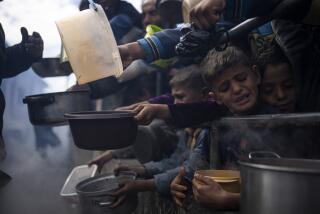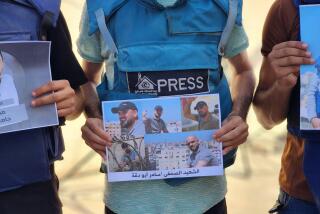Arab Casualties Mount Under Israeli Hard Line : Troops Taking Cue From Statements by Rabin Rather Than Their Standing Orders, Activists Say
JERUSALEM — Taking their cue from the hard-line public statements of Defense Minister Yitzhak Rabin rather than standing orders that restrict the use of firearms against Palestinian civilians, Israeli troops have been inflicting sharply increased casualties on anti-government protesters, civil rights activists charged here Sunday.
The activists spoke after one of the bloodiest weekends since last spring. This marked the beginning of the 11th month of anti-government unrest in the occupied West Bank and Gaza Strip, which Israel captured during the 1967 Six-Day War.
At least nine Palestinians died and more than 70 were wounded during the weekend, including two killed and 20 reported injured Sunday as troops took advantage of a general Arab strike to raid dozens of West Bank villages in search of anti-Israeli agitators.
Policy Reiterated
Rabin, who triggered U.S. and U.N. criticism late last month when he said it was his intention to increase Palestinian injuries as a way of discouraging demonstrators, reiterated that policy at a public forum in the desert town of Beersheba on Saturday.
“In confrontation, the rioters should suffer casualties and scars, so that they know it would not end just with arrests,” Israel Radio quoted him as saying. “This is my policy, and I am responsible for it.”
In September, the army introduced widespread use of plastic ammunition to implement the policy. The ammunition is said to be less lethal than conventional rounds with metal jackets, and its introduction was accompanied by a relaxation of firing orders. Unlike conventional ammunition, soldiers are permitted to use plastic bullets against stone throwers, whether or not there is any threat to their lives.
The military chief of staff, Gen. Dan Shomron, told the parliamentary Foreign Affairs and Defense Committee last week that other restrictions on the use of plastic ammunition are meant to reduce the risk of fatalities. The special rounds are not supposed to be fired from a distance of less than about 75 yards, for example, and are supposed to be aimed at rioters’ legs. Only officers and specially designated marksmen who have completed a training course are authorized to use the plastic bullets, Shomron said.
However, according to the civil rights activists, the army’s firing orders are impossible to enforce in practice, with the effect that troops in the field take their cue from Rabin’s get-tough rhetoric instead. Also, distribution of plastic ammunition among troops is much more widespread than the authorities have suggested, according to Israeli sources and press reports.
Doctors say the recent rash of casualties includes Palestinians wounded by both plastic and conventional ammunition, and many of those killed and critically injured last weekend were wounded in the head or chest.
Policy Can’t Be Controlled
“I don’t think you can control a policy when you say you should hit only with plastic bullets, only from 70 meters (about 75 yards) and more, only shot by officers,” commented Dedi Zucker, a member of the Knesset (Parliament) from the leftist Citizens Rights Movement. “I mean, that’s rubbish. . . . You cannot control the 70 meters, you cannot control the ammunition, you cannot control who is shooting.”
“I don’t see any way to make sure that people are going to be injured and not killed,” said Joshua Schoffman, legal director for the Assn. of Civil Rights in Israel.
The civil rights association says that opening fire for purposes of deterrence “is an illegal act.” It intends to press Atty. Gen. Yosef Harish to issue new guidelines for plastic ammunition “as a matter of life and death,” Schoffman said.
Policy vs. Feeling
Schoffman compared Rabin’s statements about plastic ammunition with his controversial announcement last winter that protesters should be beaten. “I think what has happened, first of all in the matter of beatings back in the winter and now with plastic bullets, is that there seems to be a written policy and then a sort of general feeling that emanates from the defense minister,” the civil rights activist said. “It seems that there has definitely been a lifting of constraints over the last couple of weeks.”
Israeli reporters who specialize in covering the occupied territories agreed. “The threshold for pulling the trigger has gone down,” commented Joel Greenberg, the Jerusalem Post’s West Bank correspondent. “That’s the bottom line.”
Another senior Israeli journalist who spoke on condition of anonymity echoed Palestinian charges that Rabin is trying to score points for his Labor Party in the current election campaign by convincing wavering voters that while Labor wants peace, it will not sacrifice Israeli security to get it.
‘Matter of the Elections’
“It’s . . . a matter of the elections,” the journalist said. “He wants to show his voters he can put an end to (the uprising).”
A Rabin aide said he could not comment on the minister’s motivation or the possible impact of his comments on troops in the field. “Your guess is as good as mine,” the aide said.
While Shomron was quoted as telling the Knesset committee last week that plastic bullets had resulted in more injuries, but fewer deaths, army figures obtained by The Times on Sunday painted a different picture.
During the three weeks prior to Shomron’s Oct. 4 appearance, there was a drop in fatalities on the West Bank--to five from seven in the previous three-week period. However, the army figures show, there was an increase to six from three in the number of fatalities in the Gaza Strip at the same time, so the total number of deaths in the territories from army gunfire actually increased by one during the period that plastic ammunition was being introduced.
Wounded Total Jumps
The number of wounded jumped to 267 during the period, almost double the 137 wounded in the previous three weeks. And two of those wounded died from their injuries later last week, after Shomron’s testimony.
An army spokesman said it is not certain how many of the casualties cited by Shomron were caused by plastic ammunition and how many by conventional rounds. However, he said, the plastic rounds “certainly have had the effect of confusing the local population.”
According to an unofficial tally, 27 Palestinians have died in unrest-related incidents in the last three weeks--a rate of fatalities comparable to some of the worst periods of the uprising last spring. Three of the dead were alleged collaborators, slain by fellow Palestinians, and the circumstances surrounding the killing of two others during the weekend are still unclear.
Of the others killed since last Friday, Israeli defense sources confirm that at least one was felled by plastic ammunition. Four of the weekend fatalities died from head wounds, and at least two of the wounded are in critical condition from bullets to the head.
Aggressive Raids
The new firing policy coincides with an aggressive army program of initiating raids on villages and refugee camps in the occupied areas. Troops on Sunday swept through 35 villages. They reportedly arrested scores of residents, seized what was described as “subversive material” and forced residents to take down banned Palestinian flags and erase nationalist graffiti.
Israel Radio quoted an unnamed senior army officer as saying that Sunday’s operation was meant “to remove rioters and stone throwers from the main traffic routes.”
Troops acted in the midst of a general strike throughout the occupied territories Sunday, called to mark the end of 10 months since the continuing unrest began last Dec. 9.
More to Read
Sign up for Essential California
The most important California stories and recommendations in your inbox every morning.
You may occasionally receive promotional content from the Los Angeles Times.










